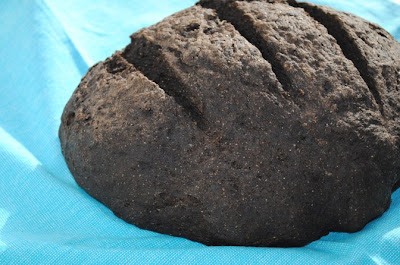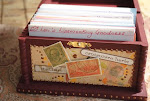 I have been on a search for a recipe that tastes like the pumpernickel you buy in the store. I love it. And those yummy pumpernickel pretzels are really good as well. So I was excited to see Temperance's, High on the Hog, recipe for rye for this month's Recipes to Rival Challenge- looking a lot like pumpernickel. I don't know maybe it was because I used Blackstrap Molasses. Maybe the recipe is not the same but I am sorry to say that this is not what I was looking for in pumpernickel. So if there is someone out there saying to yourself as you read this, "I've got a pumpernickel recipe for you." Please, please, please send it to me.
I have been on a search for a recipe that tastes like the pumpernickel you buy in the store. I love it. And those yummy pumpernickel pretzels are really good as well. So I was excited to see Temperance's, High on the Hog, recipe for rye for this month's Recipes to Rival Challenge- looking a lot like pumpernickel. I don't know maybe it was because I used Blackstrap Molasses. Maybe the recipe is not the same but I am sorry to say that this is not what I was looking for in pumpernickel. So if there is someone out there saying to yourself as you read this, "I've got a pumpernickel recipe for you." Please, please, please send it to me.
One of the highlights of this months recipe was finding out that adding wheat germ, milk powder and soy flour to some bread will up the nurtitional quotient quite a bit. "Back in the 1930's, a Cornell University professor named Clive McCay developed a bread recipe named Cornell Bread. It makes a complete protein that rats can live on exclusively. (The only reason that humans can't live on it exclusively is that it lacks vitamin C, which rats don't need.) The Cornell formula to enrich bread consists of 1 tablespoon each soy flour and nonfat milk powder plus 1 teaspoon wheat germ for each cup of flour used in a bread recipe. These enrichments are placed in the bottom of the measuring cup before the flour is spooned in." It's called McCay's Miracle Loaf.
So what exactly is the difference between rye and pumpernickel. I have read different opinions in baking books and on the web. I did a little research and found this information. "Light rye bread is made with the white rye flour made by grinding the rye berry’s center endosperm. The ground flour will not contain any of the outer seed coat, the bran or the germ so it will be fairly light in color as well as the bread made from it. For the dark rye bread, there are two ways that it can be made. The first one is exactly the way light rye is made but with coloring and some flavoring added like cocoa powder and molasses. The second way, which also seems to be more agreed upon as authentic, is where a different grind of rye flour than light is used. The flour is milled from the rye berry’s endosperm which is the part that contains more coloring pigments. The flour is usually ground more coarsely too... As for the pumpernickel bread, it is made from a kind of flour known as pumpernickel flour made from coarsely ground rye berries. In certain particular recipes, crumbs from other rye breads can be added to the pumpernickel bread dough. Pumpernickel bread loaves are usually dense and dark with strong flavoring. The flavoring is due to the fact that pumpernickel bread is usually steam baked at a low heat for over two hours, during which time flavors are formed in the bread and the natural sugar in the rye will darken and sweeten because of the long slow baking." (Click here for article. Source: Difference Between.net)
Old World Rye
A World of Breads by Dolores Casella, 1966
what I used in parenthesis
2 cups rye flour
1/4 cup (black) cocoa powder
2 T yeast
1 1/2 cups warm water
1/2 cup (black strap) molasses
2 tsp (kosher) salt
2 T (ground) caraway seed
2 T butter
2 1/2 cups white flour or whole wheat flour
Combine the rye flour and cocoa. do not sift.
Dissolve the yeast in 1/2 cup warm water.
Mix molasses, 1 cup warm water, salt, and caraway seed in large mixing bowl.
Add the rye/cocoa mix, the proofed yeast, the butter and 1 cup white flour or whole wheat flour.
Knead until the dough is smooth.
Spread the remaining flour on a breadboard and knead it into the dough
Add more flour if necessary to make a firm dough that is smooth and elastic. Place in buttered bowl and cover. Allow to rise until double (about 2 hours).
Place in buttered bowl and cover. Allow to rise until double (about 2 hours).
Punch dough down, shape into a round loaf and place on a buttered cookie sheet that has been sprinkled with cornmeal.
Let rise about 50 minutes. Bake at 375 for 35 to 40 minutes.
Bake at 375 for 35 to 40 minutes.
Bench Notes (I love saying that- it makes me feel so professional):
1. If I were to try this recipe again I would use regular molasses.
2. I would use the black cocoa again because it gives the bread a nice color. And since I have some of it and I am not quite sure what to do with it besides make cholocate wafer cookies, I think I will use it for pumpernickel.
Tuesday, December 1, 2009
Recipes to Rival: Rye Bread
Labels:
bread,
Recipes to Rival
Subscribe to:
Post Comments (Atom)











12 comments:
What a beautiful dark loaf! I really meant to make this as well but fell so behind this month that I just bought rye flour yesterday!
deep, dark, and hearty bread. i'm a huge rye fan, not only because it's filling and tasty, but also because it's just so much fun to say! riiiiiiii. :)
Your bread is lovely, Lori. Sometimes dark molasses overwhelms a bread.
Dark & tasty, this looks so good. Of the many breads I've made, I haven't made a pumpernickel yet. I give it a try soon. ;-)
Lori, this looks good to me. I make a rye bread from the King Arthur 200th Anniversary cookbook. It's very good, but still not great. Their website sells a flavor enhancer, and I'm wondering if that's not the secret?
So glad you liked the apple cider brine! That is one of my favorite recipes of all time :D
I'd love to give pumpernickel a go some day - if you find a fantastic recipe, let me know :)
This bread looks fascinating - that colour!
I never knew about Cornell bread! My mom for years has added the "good" stuff to her bread and rolls. Wheat germ, flax, soy...
:o)
I've never seen a rye bread made with black cocoa, but wow, is that dramatic! I feel like it would be an especially great thing to serve on Halloween.
i was wondering what the bread would look like i had used dark cocoa instead. dark bread is just so beautiful!
It looks so dark and chewy!
a beautiful color, I was wondering about using something less strong than molasses myself, the bread itself was pretty tasty.
Post a Comment